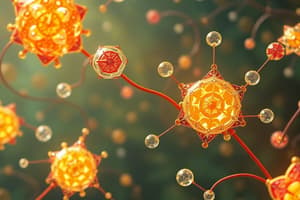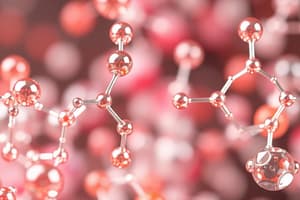Podcast
Questions and Answers
What should you assume about an ion if its charge is not indicated?
What should you assume about an ion if its charge is not indicated?
- It is a polyatomic ion.
- It has a neutral charge.
- It has the most common charge. (correct)
- It does not form ionic compounds.
In the Stock system of nomenclature, what is used to indicate the charge of a metallic cation?
In the Stock system of nomenclature, what is used to indicate the charge of a metallic cation?
- Greek prefixes
- Roman numerals (correct)
- Suffixes
- Subscripts
What is the ending for non-metallic ions when naming ionic compounds?
What is the ending for non-metallic ions when naming ionic compounds?
- -ate
- -ous
- -ide (correct)
- -ite
In the classical naming system, what are used to differentiate between different ions of the same metal?
In the classical naming system, what are used to differentiate between different ions of the same metal?
When writing the formula for an ionic compound, what is the first step after identifying the symbols and charges of the ions?
When writing the formula for an ionic compound, what is the first step after identifying the symbols and charges of the ions?
Which of the following suffixes commonly appears at the end of polyatomic ion names?
Which of the following suffixes commonly appears at the end of polyatomic ion names?
What type of bonds are present within a polyatomic ion?
What type of bonds are present within a polyatomic ion?
In chemical formulas involving polyatomic ions, what does the use of brackets indicate?
In chemical formulas involving polyatomic ions, what does the use of brackets indicate?
When naming ionic compounds with polyatomic ions, which element is named first?
When naming ionic compounds with polyatomic ions, which element is named first?
In the formula $Al(NO_3)_3$, what does the subscript '3' outside the brackets indicate?
In the formula $Al(NO_3)_3$, what does the subscript '3' outside the brackets indicate?
Flashcards
Polyatomic Ions
Polyatomic Ions
Ions made of two or more elements that stay together as a unit when forming compounds.
Naming Ionic Compounds with Polyatomic Ions
Naming Ionic Compounds with Polyatomic Ions
List the metallic element using its full name (Roman numeral if needed), then name the non-metallic ion using its exact name from the polyatomic ion chart.
Formula Writing with Polyatomic Ions
Formula Writing with Polyatomic Ions
Write the symbols and charges (positive first), then drop and cross the charges to balance the formula.
What is a polyatomic ion?
What is a polyatomic ion?
Signup and view all the flashcards
Bonding within Polyatomic Ions
Bonding within Polyatomic Ions
Signup and view all the flashcards
Multivalent Metal Ions
Multivalent Metal Ions
Signup and view all the flashcards
Stock System (Classical)
Stock System (Classical)
Signup and view all the flashcards
"ide" Ending
"ide" Ending
Signup and view all the flashcards
Common Charge Order
Common Charge Order
Signup and view all the flashcards
Formula Balancing
Formula Balancing
Signup and view all the flashcards
Study Notes
Ionic Compounds - Polyatomic Ions
- Polyatomic ions have distinct characteristics and commonly end with "ate" or "ite".
- They consist of two or more elements and reside on the Polyatomic ion table above the periodic table.
- All elements and ion numbers usually stay as one when they form compounds in the polyatomic ion.
- Bonds are molecular/covalent within the polyatomic ion, i.e., Mg2+ + MnO4- becomes Mg(MnO4)2.
- The number is acquired from the cross and should be brought down to balance the formula; it applies to the whole ion.
- Naming the compound involves stating the metallic element first with it's full name and a Roman numeral designation.
- Follow with the non-metallic ion, using its exact name from the polyatomic ion chart.
- To derive the formula, write the symbols with their charges but always name the positive ions first then the negative ones.
- Cross over and drop the charges and determine the compound state, pure ionic compounds are always solid.
- Iron(II) and nitrate can be combined to form the formula Fe(NO3)2(s), and aluminum and nitrate Al(NO3)3(s).
Studying That Suits You
Use AI to generate personalized quizzes and flashcards to suit your learning preferences.




